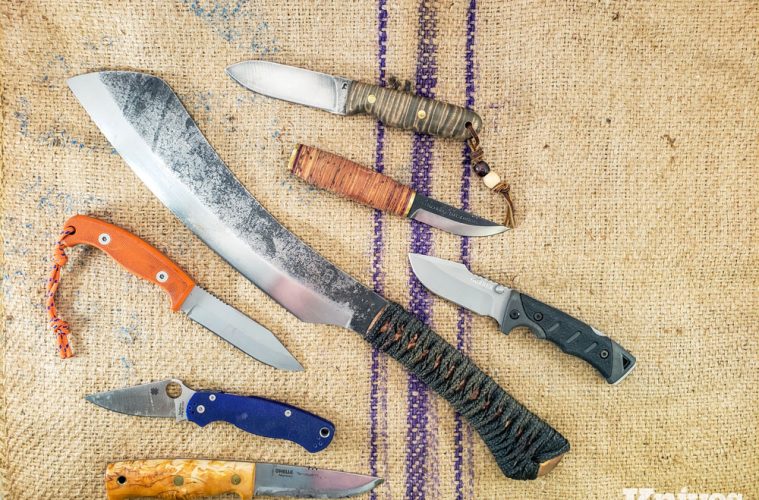Let’s get a grip on knife handle benefits, materials, and functionality
Knives are one of human’s earliest tools. The first flint knives and scrapers didn’t have handles, but people soon learned to lash wooden or bone ones in place to increase leverage, keep their hands away from the cutting edge, and to improve performance.
We’ve come a long way since then, but the basic concept remains the same; a good handle improves the performance of your knife. But what makes the perfect knife handle?
Is there even such a thing? Let’s take a look at the various knife handle materials used as well as their pros and cons under both normal and extreme use.
METAL
The most basic type of knife handle is no handle at all. Some knives are either forged or ground as one piece, so there’s really nothing like an added pommel, guard, or scales to break, making the construction process simpler and making the overall design very rugged.
That bare steel can be slippery though, depending on the texture left on the metal, the shape of the handle, or the addition of any grooves or checking.
The bare metal is also susceptible to extremes of heat and cold that can make using the tool uncomfortable to use without gloves.
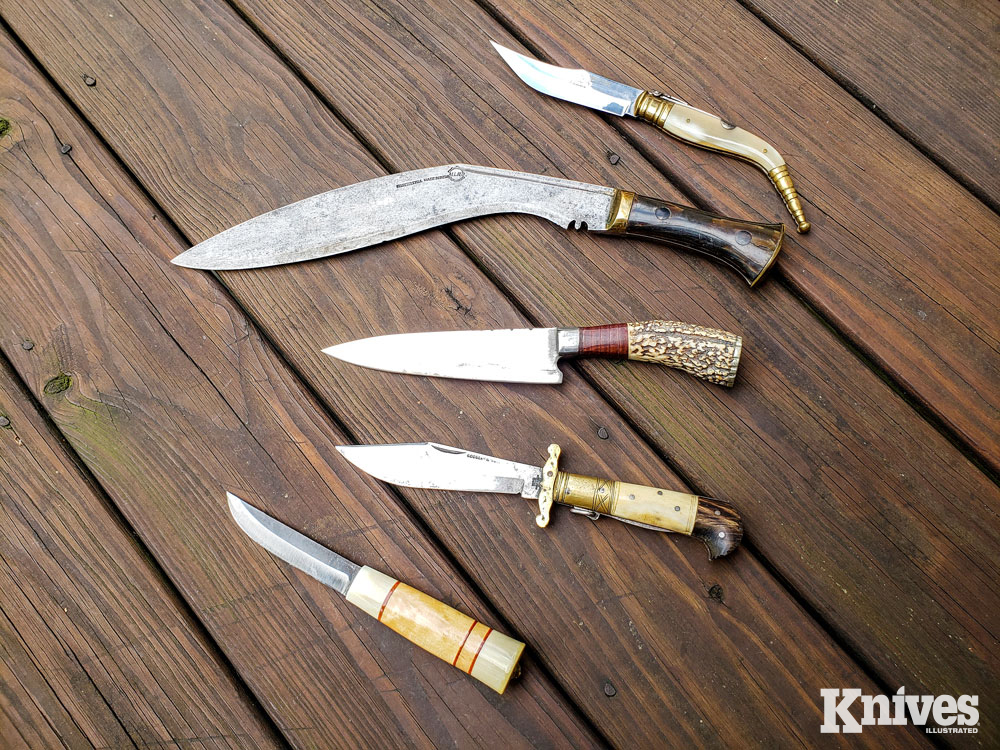
Bone, stag, and horn are popular handle materials that have been around for as long as humans have made knives
In addition to a one-piece knife, you also will sometimes see metal scales used, often aluminum or titanium. While scales like this still can suffer from being uncomfortable in extreme heat or cold, they often have a checkering or texture added that improves the grip.
Aluminum in particular can be anodized in a wide variety of colors, too, allowing for great design touches.
The other metal handle style you’ll sometimes see is a cast brass or aluminum handle. They suffer the same benefits and drawbacks that the other style metal handles do.
They’re affected by extremes of heat and cold and can be slippery depending on the grip texture. Also, they are generally durable though, and some castings can allow for intricate design features.
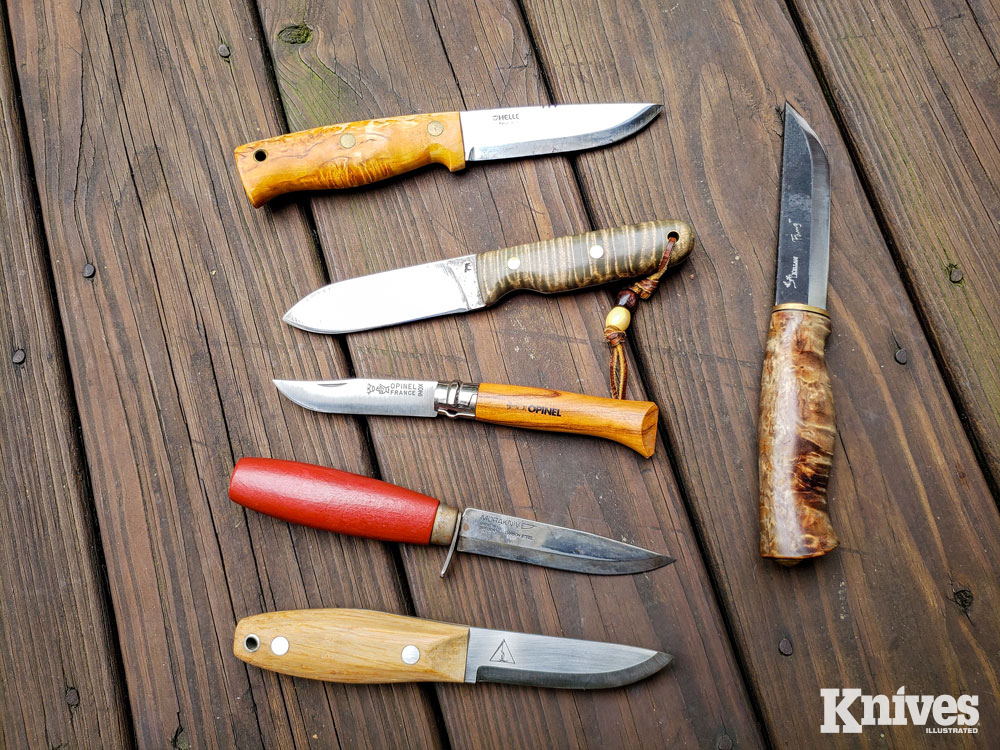
Wood is one of the earliest handle materials used on knives, and it’s still very popular today with both custom makers and production knife companies.
Bone/Stag/Horn
I’m lumping bone, antler, and horn together on this one, basically representing any natural material as harvested from animals. You could probably include ivory here, too, although it’s not especially common these days due to its price, rarity, and restrictions.
Bone or horns are probably one of the earliest materials used for knife handles due to availability from game animals killed for food.
Our ancestors were quite good at making use of all parts of the animal, so the bones, horns, and antlers were often turned into tools of their own, and later into handles or parts of handles for flint knives.
These materials remained popular as humans transitioned to bronze and then steel, and you still see them used frequently on custom, and some production, knives today.
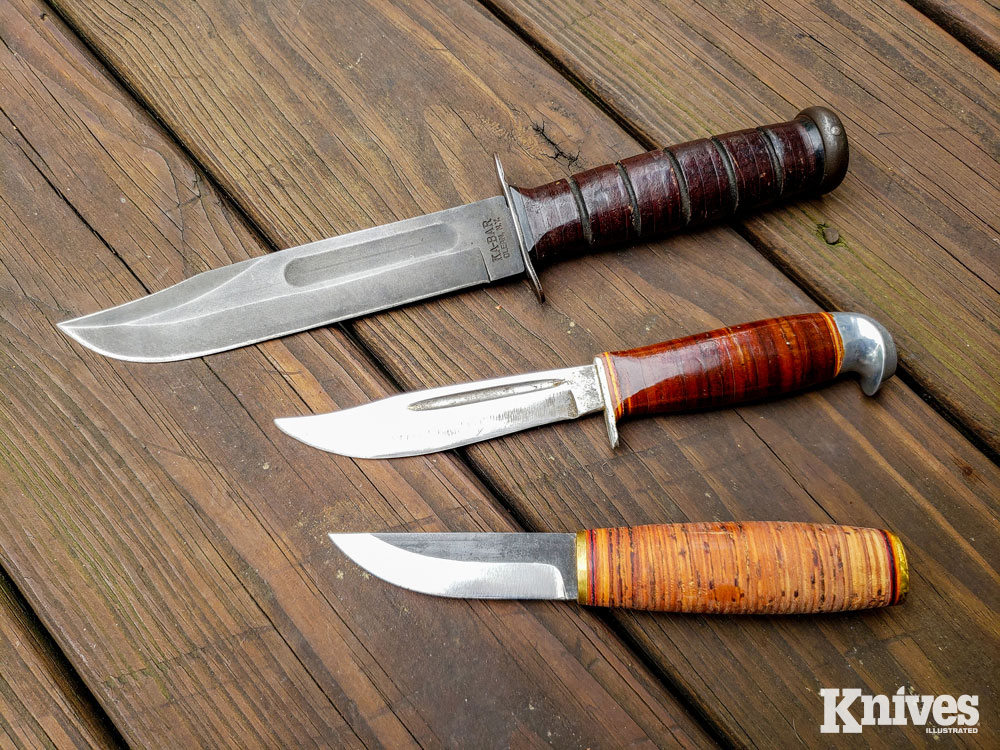
Stacked leather and stacked birch bark handles make for attractive and functional options for a user looking for a traditional style handle.
Bone can dry and crack, or absorb moisture and expand, so while it certainly can and has been used in its natural state, it’s best stabilized for use in handles today.
Bone and ivory generally have a smooth texture; you can also checker or engrave them, adding both aesthetic qualities and texture for a better grip. Antler often has a rougher texture naturally, which is why you frequently see stag left in the rough when used for handles.
An advantage of stag is that it’s made from shed antlers so it’s a renewable handle material that doesn’t harm the animal when you harvest it.
Wood
Along with bone and horn, wood was one of the first materials used for knife handles and it’s also still very popular today. It’s readily available, easy to work with, and can have natural beauty, especially with woods like rosewood, cocobolo, desert ironwood, or the various burls and spalted woods.
Simpler woods such as hickory may not have the flair that some of the exotic woods do, but it’s a cheap and readily available material that was used on many trade and kitchen knives.
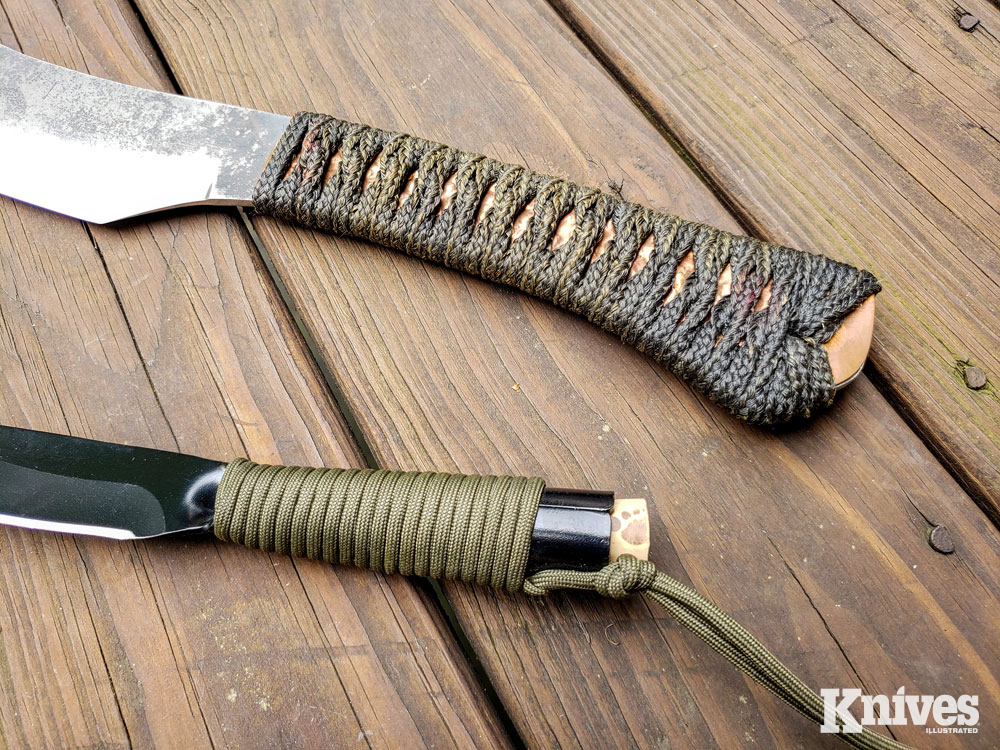
Cord wrap can be done to enhance beauty and grip like on the PB&J Big Jake, or just to provide some extra cordage in a survival situation like on the Cold Steel Mini Bushman.
Wood varies in hardness and durability and can be prone to shrinking and cracking if not dried properly or stabilized. Harder woods don’t generally require stabilization whereas softer woods and burls do.
Stabilization consists of removing the moisture from the wood using a vacuum process and replacing it was an epoxy resin so that the wood won’t expand and contract with changes in temperature and humidity.
Wood is a blank canvas for a knifemaker. It can be made into simple scales, mortised out to encompass the tang, or drilled out to accept a rat tang. It can also be left smooth, or checkered, ribbed, or carved to add additional aesthetic touches and to enhance grip.
Stacked Leather or Birch Bark
Another early handle material was leather, either wrapped around a metal tang or wooden handle, or stacked in leather disks such as with the famous KA-BAR military knives.
Stacked leather handles have great warmth to them and, as they fully encompass the tang of the knife, insulate the user from extremes of heat and cold.
They generally are aesthetically pleasing to most users as well. All in all, they’re a classic handle that works well, looks good, and makes use of natural material.
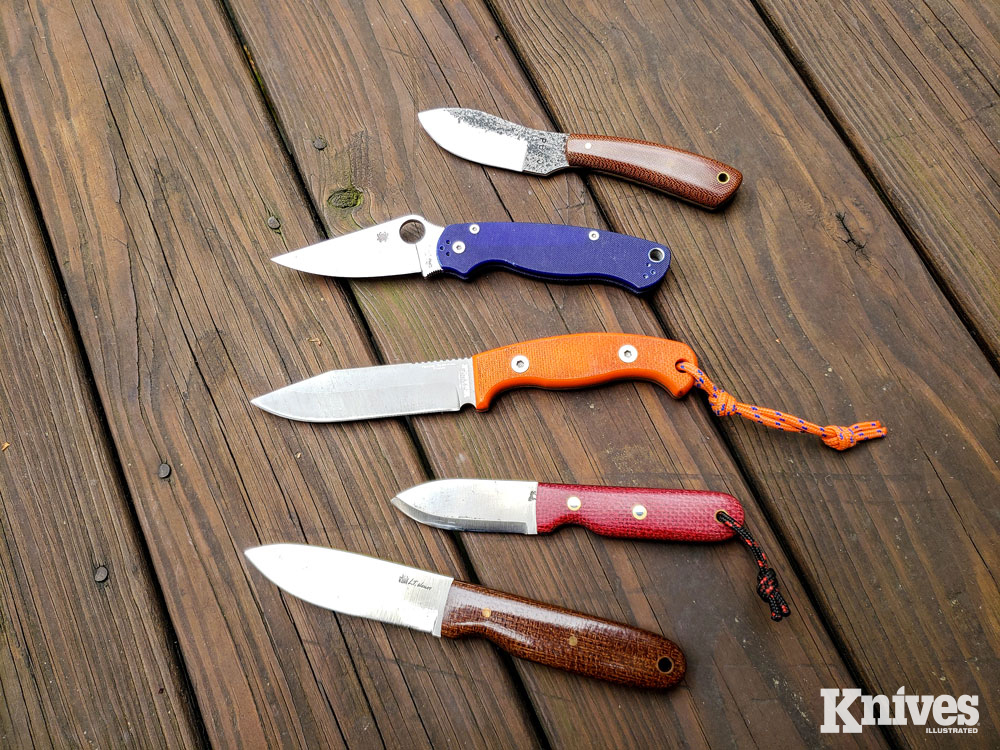
G10 and Micarta can be had in myriad colors and can be contoured or textured to provide a solid grip. These materials are also very durable, and impervious to most weather and environmental conditions.
In Scandinavian countries, cut disks of birch bark are stacked and used in the same manner as stacked leather handles are elsewhere.
They provide an amazingly comfortable grip and make use of a renewable resource in their construction. Like leather, they also make for an attractive grip.
A downside to both grips is that they can dry out and leather particularly can rot in hot, humid environments.
Cord Wrap
Cord wraps are a step up from bare metal handles. They can be anything from old fashion Jute twine to modern paracord or something in between. They typically offer a good grip if wrapped correctly, even when wet, although they aren’t generally as comfortable as solid grip or wood, Micarta, or other material.
Some cord wraps will use an epoxy coating to bond them to the handles, making a more durable and often more comfortable grip. If they simply are wrapped and tied though, they also give the user cordage that can be used in a survival or emergency situation, although this then leaves your knife with a bare handle.
Cord wraps can be simple affairs that basically consist of winding the cord around the handle snugly to the intricate Japanese style Tsukamaki handle wrapping used on Katanas and mimicked on some modern custom and even production knives.
A downside of cord wrapping is that if they get contaminated with blood or some other hazard, they’re hard to clean and you may just end up having to replace the wrap.
Micarta/G10/Carbon Fiber
Micarta, G10, and carbon fiber are all similar materials in that they are a laminate made by soaking layers of material in resin and compressing and heating them until they set and form a solid block that can then be cut, ground, and shaped.
They all have very good electrical insulating properties, are durable and weather resistant. All in all, they’re excellent handle materials with few drawbacks.
Micarta was first used in the electrical industry and is made from layers or paper, linen, or canvas. While the term is commonly used to describe the whole class of materials Micarta is actually the registered trademark of Norplex-Micarta Industrial Plastics and has been since 1912.
It (Micarta) comes in a wide variety of colors and can be left with a rougher texture for improved grip, even when wet. It’s relatively impervious to weather, although it can stain. It is very popular with custom makers and it can be found on some production knives as well.
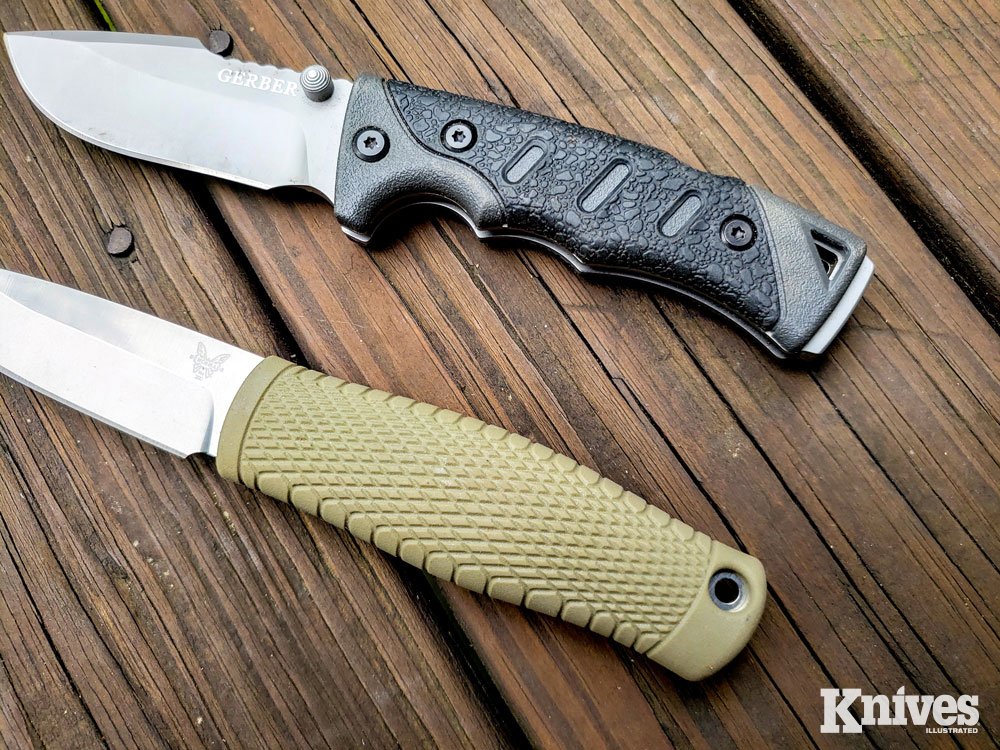
Rubber handles are practical and work well in foul weather conditions or when your handle is slippery with water or blood. They make a good choice for hard use hunting and military knives. You typically see rubber handles on mass produced commercial knives from companies such as the ones shown here from Gerber and Benchmade.
G10 is similar to Micarta, but instead of being cloth- or paper-based it uses a fiberglass laminate. G10 is a bit tougher than Micarta and impervious to moisture.
Again, it comes in a wide array of colors. It generally has a smoother finish than Micarta, but the grip can be enhanced with whatever texture or grip pattern the make or company chooses to apply. G10 is a common material on custom and higher-end production knives.
Carbon fiber handle scales are made using layers of carbon cloth soaked in resin. It has similar properties to G10. Black and gray are the most common colors for carbon fiber scales, although other colors are available.
The pattern of the carbon fiber cloth adds interesting depth to the scales that you don’t see with G10 or Micarta. Carbon fiber is also much lighter than other handle materials including G10 and Micarta, so it’s a good choice when weight is a concern.
Rubber
Rubber handles, such as Kraton, offer arguably the best grip out there of all the various handle materials, especially in wet conditions. Depending on the rubber used, they have some flex to them when you squeeze and that, coupled with whatever texture or checkering is applied, practically weld your hand to the grip.
They also tend to be a warmer grip than metal or other synthetics and work very well in wet or messy conditions. Cleanup is generally very easy, too, and they’re resistant to staining.
Rubber grips are cheaper for mass production, but they require molds and industrial equipment, so they aren’t well suited to the custom knifemaker.
Rubber is pretty rugged, but it can dry out and rot, be cut, or even chewed. I’ve seen more than one rubber handled knife chewed on and ruined by someone’s pet.
Plastic/FRN
Plastic handles have a few advantages in that they’re generally impervious to weather and can be made in any shape or texture the designer can envision. They’re durable as well, at least as long as a good polymer is used.
FRN (Fiberglass Reinforced Nylon) and Zytel are materials you see used by some of the bigger production companies such as Spyderco and Gerber. Basically, that’s a polymer reinforced with fiberglass that makes for a stronger, tougher blend than basic plastic.
These materials are inexpensive but very rugged, but like rubber handles require molds and equipment to make handles so they’re best suited to production knives.
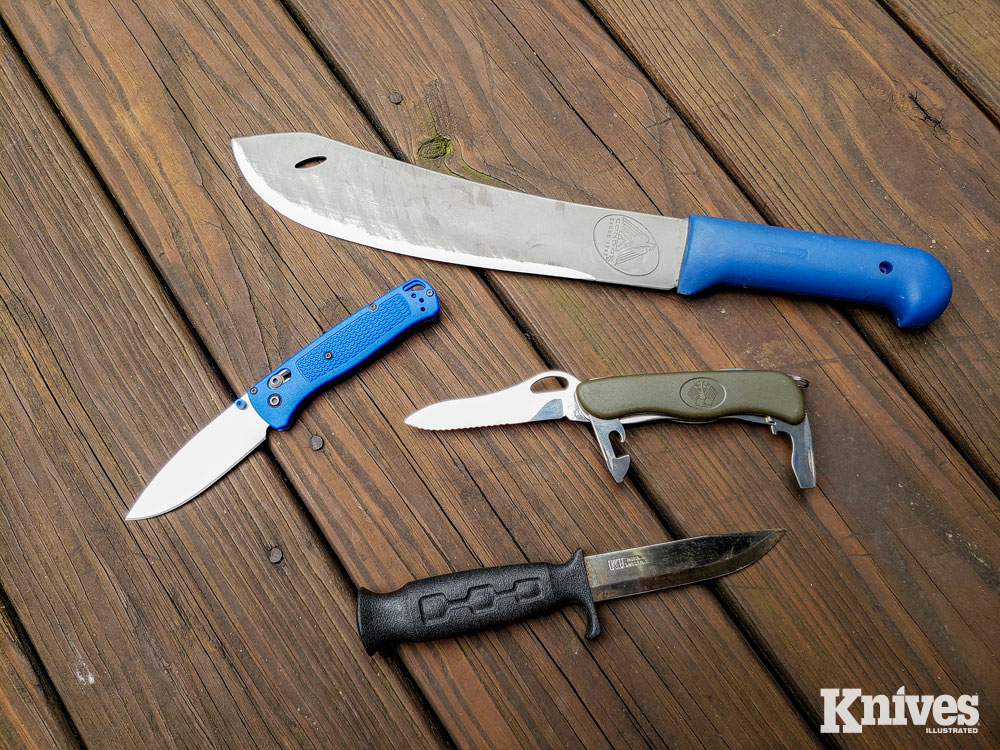
Plastics are practical and affordable and can be molded in a wide variety of styles, colors, and patterns. Plastic handles can be lightly textured like with the Condor Inca knife (top, right), molded with inset patterns like on the author’s old Mora (bottom, right), or checkered like the Grivory handles on the Benchmade Bugout
Other Materials
While the above covers most of the common materials used for knife handles, you will definitely run into other things in your travels, especially on art knives.
Things like mother of pearl, jade, and other exotics may make for beautiful knives, but they aren’t necessarily for working tools, so you have to keep in mind what your intended purpose is with your knife when you consider them.
Chances are if there’s a material you can think of, some knifemaker has probably tried using it for a knife handle.
The Perfect Handle
So, is there such a thing as the perfect handle or handle material? There might be something out there that feels right and suits your needs perfectly. But that might not be the same thing that works for me or someone else.
The great thing is that we have tons of options these days and finding that perfect one for us is within reach. And if you haven’t found it yet, just keep looking! Your options are endless and knifemakers and manufacturers come out with something new seemingly every day. KIBG
__________________________________________________________
GET A GRIP!
With so many styles of knives on the market, there are endless varieties of handles available. But not all of them are created equally.
For a light duty EDC knife that may just see jobs like cutting string, tape, or opening envelopes, having a hand-filling, comfortable handle might not be a big issue. For something that’s going to see heavier use as a work knife, hunting knife, bushcraft tool, or self-defense tool, your handle matters a lot more.
You need a grip that’s solid and comfortable, something that you can use for long periods of time without causing hand fatigue or getting blisters and stays put under impact or harsh environmental conditions.
Checkering, handle grooves, texture, and spine jimping can all enhance a grip, but if they’re too aggressive or have sharp corners, they can cause hot spots and lead to the fatigue and blisters.
Similarly, handle length and thickness can play a big part in what’s comfortable as well. Over-gripping a thin handle can increase hand fatigue, as can trying to hold onto a grip that’s too short.
Editor’s note: A version of this article first appeared in the KI Buyer’s Guide 2021 print issue of Knives Illustrated.

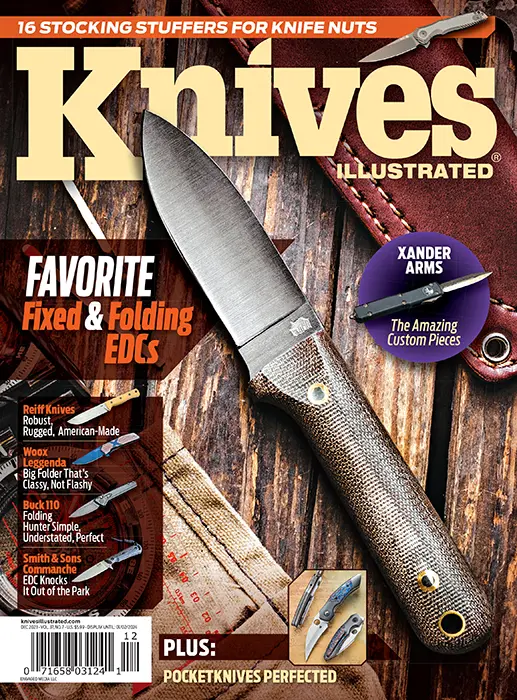 Subscribe / Back Issues
Subscribe / Back Issues